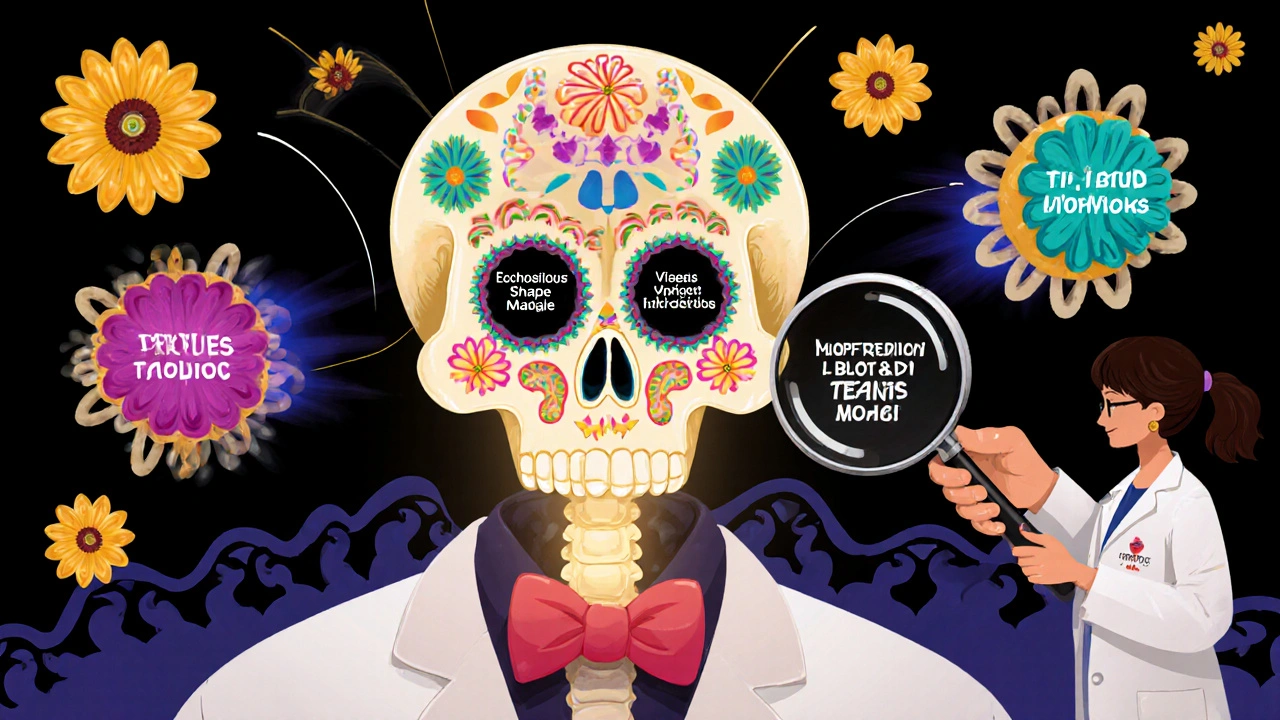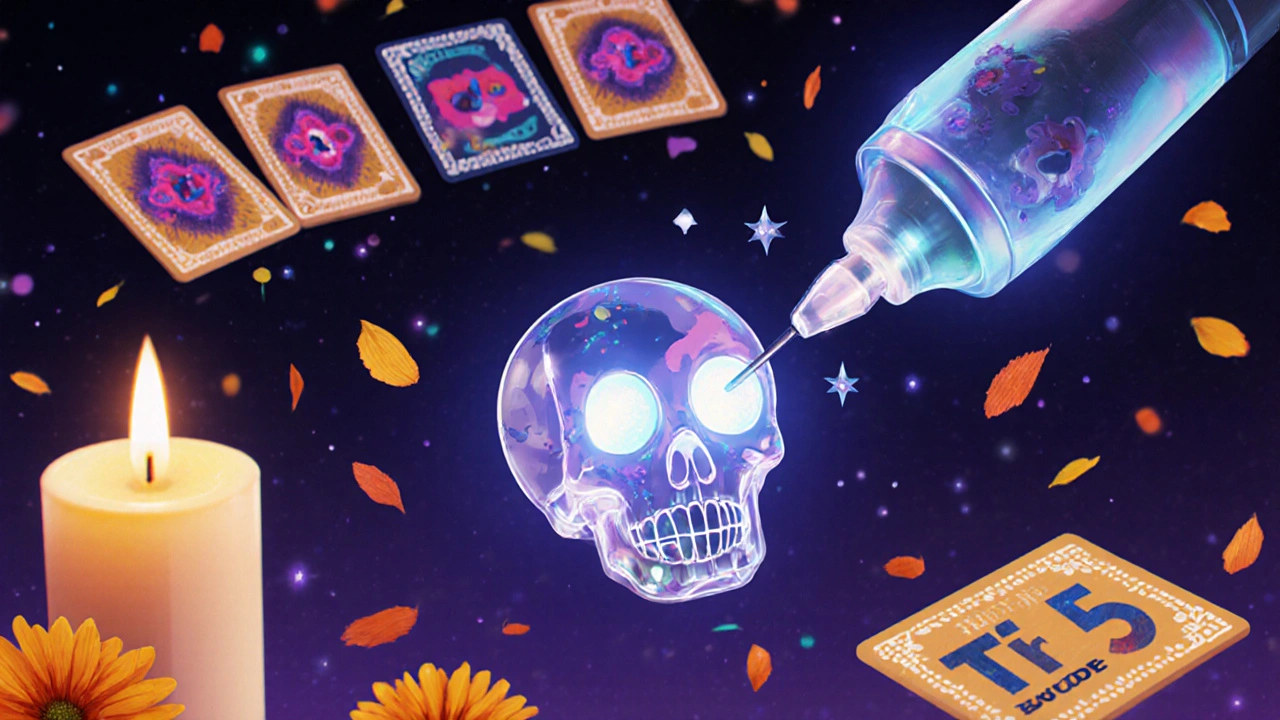Thyroid Ultrasound: How Imaging Nodules Reveals Cancer Risk
 Nov, 7 2025
Nov, 7 2025
When your doctor finds a lump in your neck, the first test you’ll likely get isn’t a biopsy - it’s a thyroid ultrasound. It’s quick, painless, and doesn’t use radiation. But what you might not realize is that this simple scan does more than just show a nodule. It tells you how likely that nodule is to be cancer - and whether you need to act now or wait.
Why Ultrasound Is the First Step
Physical exams alone miss most thyroid nodules. Studies show doctors feel only 2-21% of them. Ultrasound catches 19-68%. That’s because sound waves bounce off tissue in real time, creating a live image of your thyroid - down to the tiniest detail. No needles. No radiation. No waiting. And it’s cheap, usually costing between $200 and $500 in the U.S.It’s not just about finding a lump. It’s about reading it. The shape. The texture. The blood flow. These aren’t random details. They’re clues. And radiologists have spent decades turning those clues into a system that tells you risk - not just suspicion.
The TI-RADS System: Decoding the Scan
In 2017, the American College of Radiology created TI-RADS - Thyroid Imaging Reporting and Data System. It’s not a guess. It’s a scoring tool. Five features get points:- Composition: Is it full of fluid (cystic)? Full of solid tissue? Or a mix? Solid nodules carry more risk.
- Echogenicity: How bright or dark does it look? Markedly hypoechoic (very dark) nodules are more likely to be cancerous.
- Shape: A nodule that’s taller than it is wide? That’s a red flag. Normal nodules are wider.
- Margin: Smooth edges? Low risk. Jagged, blurry, or spreading outside the thyroid? Higher risk.
- Punctate echogenic foci: Tiny white dots inside the nodule - microcalcifications. These are one of the strongest signs of cancer.
Each feature gets 0 to 3 points. Add them up, and you get a TI-RADS category:
- TR1 (0 points): 0.3% cancer risk - ignore it.
- TR2 (2 points): 1.5% risk - still very low.
- TR3 (3 points): 4.8% risk - monitor with another scan in a year.
- TR4 (4-6 points): 9.1% risk - biopsy recommended.
- TR5 (7+ points): 35% risk - biopsy almost always needed.
This system replaced older, vaguer guidelines. Studies confirm TI-RADS predicts cancer better than anything before it. It’s why most doctors now skip nuclear scans - they’re outdated for initial evaluation.
What Ultrasound Can’t Do
Ultrasound is powerful, but it’s not magic. It can’t say “yes, it’s cancer.” Only a biopsy can. That’s why even a TR5 nodule doesn’t mean surgery right away - it means you need a fine-needle aspiration (FNA).Here’s the catch: ultrasound guides that biopsy. Without it, you might miss the nodule or get a bad sample. When done without ultrasound, FNA fails in 25% of cases. With ultrasound? Less than 5%. That’s the difference between a clear answer and months of uncertainty.
Some nodules are tricky. If the biopsy comes back “indeterminate,” you’re stuck in limbo. That’s where molecular testing comes in - it checks for specific gene changes that signal cancer. But even then, you still need ultrasound to track the nodule over time. No test replaces watching it.

Size Matters - But Not How You Think
Most people assume bigger nodules = more dangerous. Not always. A 1 cm nodule with TR5 features is more concerning than a 3 cm nodule that looks completely benign.Guidelines say: biopsy nodules 1 cm or larger if they’re suspicious (TR4 or TR5). But if a nodule is under 5 mm? Even if it’s solid and dark - skip it. The chance of it being harmful is near zero. No need to stress, no need to biopsy.
And here’s something surprising: many small papillary thyroid cancers (under 1 cm) don’t need surgery at all. Studies show 10-year survival is over 99% with active surveillance - just regular ultrasounds every 6-12 months. Surgery has risks: nerve damage, lifelong thyroid hormone pills. For low-risk cases, watchful waiting is now the standard.
What About Other Scans? CT, MRI, Nuclear
CT and MRI can find thyroid nodules by accident - often when you’re scanned for something else. But they can’t see the fine details that predict cancer. No microcalcifications. No shape analysis. No Doppler flow. They’re useless for risk assessment.Nuclear scans (radioactive iodine uptake) tell you if a nodule is “hot” or “cold.” Hot nodules almost never turn cancerous. Cold ones have about a 15% chance. But here’s the problem: you still don’t know if it’s cancer. And you get radiation exposure. That’s why guidelines now say: skip nuclear scans unless you’re checking thyroid function. Ultrasound is always first.
Who Reads the Scan? Expertise Matters
Not all ultrasounds are equal. A tech can press buttons. A radiologist reads meaning into the image. Studies show it takes 200-300 supervised scans for a radiologist to reach 90% accuracy in TI-RADS scoring.Inter-observer variability is real. One doctor might call a margin “ill-defined.” Another says “smooth.” That’s why accreditation matters. Facilities certified by the American Institute of Ultrasound in Medicine (AIUM) must prove they get 90% accuracy on 50 consecutive cases.
One of the most common mistakes? Not checking the lymph nodes in the neck. About 35% of community ultrasounds miss this. But cancer spreads to lymph nodes early. If they’re swollen or abnormal, that changes everything.

The Future: AI and Personalized Risk
A 2023 study in Nature Scientific Reports showed a new AI model that looks at nodule shape, texture, and blood flow - and gets 94.2% accuracy. That’s better than most human radiologists (87.6%).It’s not replacing doctors. It’s helping them. AI flags subtle patterns humans might miss. The American College of Radiology is updating TI-RADS in 2024 to include AI-validated features. Soon, you might get a risk score that combines ultrasound data with genetic markers from a biopsy.
Dr. Elizabeth N. Pearce from Boston University predicts: “Within five years, we’ll have personalized risk scores - not just ‘high’ or ‘low.’ We’ll say, ‘Your nodule has a 12% chance of being cancer based on its shape, your age, and your gene profile.’” That means fewer unnecessary biopsies and smarter decisions.
What Happens After the Scan?
If your nodule is TR1 or TR2: no action needed. Just keep your regular check-ups.If it’s TR3: come back in 12 months for another ultrasound. Most won’t change.
If it’s TR4 or TR5: you’ll get a biopsy. If it’s benign, you still need follow-up scans - cancer can grow slowly. If it’s malignant, you’ll talk to a surgeon. But remember: not all thyroid cancers need immediate removal. Many are slow-growing and safe to monitor.
And if your biopsy is indeterminate? Molecular testing can help. It cuts unnecessary surgeries by half. But don’t stop the ultrasounds. Keep watching.
Final Thought: Ultrasound Is Your Map
Thyroid ultrasound isn’t a diagnosis. It’s a map. It shows you where the danger might be - and where it isn’t. It tells you when to act, when to wait, and when to do nothing at all.It’s not perfect. But right now, it’s the best tool we have. And for most people, it’s enough to avoid fear, unnecessary procedures, and the long road of uncertainty.
Can a thyroid ultrasound tell if a nodule is cancerous?
No, a thyroid ultrasound cannot definitively diagnose cancer. It assesses features like shape, texture, and blood flow to estimate cancer risk using the TI-RADS system. Only a fine-needle aspiration biopsy can confirm whether a nodule is malignant. Ultrasound’s role is to guide which nodules need biopsy and which can be safely monitored.
How often should I get a thyroid ultrasound if I have a nodule?
It depends on the TI-RADS score. TR1 and TR2 nodules usually need no follow-up. TR3 nodules (low suspicion) should be rechecked in 12 months. TR4 and TR5 nodules require biopsy, and if the result is benign, follow-up ultrasounds are typically done every 6 to 12 months for at least 2 years to ensure stability. Growing nodules, even if benign, may need further action.
Are all thyroid nodules dangerous?
No. Up to 60% of adults have thyroid nodules, but over 90% are benign. Most are harmless and never cause symptoms. Only about 5-10% turn out to be cancerous. Size doesn’t always matter - a small nodule with suspicious features can be more concerning than a large one that looks normal on ultrasound.
Do I need a biopsy for every thyroid nodule?
No. Biopsies are recommended for nodules 1 cm or larger with suspicious ultrasound features (TI-RADS 4 or 5). Nodules under 5 mm are rarely dangerous, even if they look suspicious - and don’t need biopsy. For nodules between 5 mm and 1 cm, the decision depends on risk factors like family history or prior radiation exposure. Always discuss your individual case with your doctor.
Is thyroid ultrasound safe during pregnancy?
Yes, thyroid ultrasound is completely safe during pregnancy. It uses sound waves, not radiation, so it poses no risk to the developing baby. In fact, it’s the preferred method for evaluating thyroid nodules in pregnant women, especially since thyroid disorders are common during pregnancy and can affect both mother and child.
Can AI replace radiologists in reading thyroid ultrasounds?
Not yet. AI tools are being developed to improve accuracy - one 2023 model reached 94.2% diagnostic accuracy - but they’re used as assistants, not replacements. Radiologists interpret context, patient history, and subtle variations AI might miss. AI helps reduce human error and standardize readings, especially in busy clinics, but final decisions still require expert judgment.
Jim Oliver
November 9, 2025 AT 13:26Let’s be real-TI-RADS is just fancy jargon for ‘guess based on shapes.’ I’ve seen radiologists argue over whether a nodule is ‘slightly irregular’ or ‘definitely jagged.’ It’s not science; it’s astrology with ultrasound probes.
William Priest
November 10, 2025 AT 14:56bro i got a 3mm nodule and my doc said ‘eh, chill’… then i read this and now i’m convinced im gonna die of thyroid cancer by 30. why does medicine even exist if you can just google and panic?
Ryan Masuga
November 10, 2025 AT 15:56Actually, this is super helpful! I had no idea ultrasound could give you a risk score like that. I thought it was just ‘there’s a lump’ or ‘no lump.’ Learning that small nodules under 5mm are usually harmless is a huge relief. Thanks for breaking it down clearly!
Jennifer Bedrosian
November 11, 2025 AT 12:37OMG I JUST FOUND OUT I HAVE A NODULE AND I’M CRYING RIGHT NOW BUT THIS ARTICLE MADE ME FEEL A LITTLE BETTER LIKE MAYBE I DONT HAVE TO HAVE SURGERY LIKE RIGHT NOW?? THANK YOU SOMEONE FINALLY TOLD ME THE TRUTH
Lashonda Rene
November 13, 2025 AT 12:20So I’ve been reading this and I think it’s really important to understand that not every bump is a big deal. Like I know people get scared when they hear ‘cancer risk’ but honestly most of these nodules are just there and they don’t do anything. It’s like having a mole on your skin-you don’t cut it off unless it starts changing. And ultrasound is just a way to watch it over time, not to panic. I feel like we’ve been conditioned to think every little thing needs fixing, but sometimes the best thing is just to wait and see.
Andy Slack
November 14, 2025 AT 05:47Knowledge is power. This is the kind of info that turns fear into action. Don’t just accept ‘we’ll monitor it’-ask for the TI-RADS score. Demand clarity. You’re your own best advocate.
Rashmi Mohapatra
November 15, 2025 AT 07:01you americans overthink everything. in india we just get a quick check and if its big we cut it. no scoring systems no ai no 12 page reports. why make it complicated when simple works?
Abigail Chrisma
November 16, 2025 AT 09:05Thank you for sharing this so thoughtfully. As someone who’s navigated thyroid health with cultural stigma around ‘female’ health issues, this clarity is powerful. The fact that ultrasound is safe during pregnancy? That’s life-changing info for so many. Let’s keep spreading this.
Ankit Yadav
November 16, 2025 AT 12:33I work in a rural clinic where we don’t always have trained radiologists. The part about lymph nodes being missed in 35% of cases? That’s real. We need better training and access, not just fancy scoring systems. Ultrasound is great-but only if someone knows how to read it.
Meghan Rose
November 16, 2025 AT 17:47Wait so if I have a TR4 nodule and I don’t get a biopsy… is that like… medical negligence? Because I’m terrified of needles and I just want to ignore it. But what if I’m the one who dies because I didn’t act? I feel like the system is gaslighting me into doing something I don’t want to do.
Steve Phillips
November 17, 2025 AT 18:53AI? 94.2% accuracy? Oh please. You mean the same AI that thinks a cat is a toaster? And now we’re trusting it with cancer risk? This isn’t progress-it’s corporate laziness. Radiologists spent decades mastering this. Now they’re being replaced by a neural net trained on 10,000 blurry scans from a Walmart clinic.
Rachel Puno
November 19, 2025 AT 04:21My mom had a TR5 nodule and they did the biopsy. Turned out benign. She still gets checked every year. No surgery. No meds. Just peace of mind. This isn’t about fear-it’s about being smart. You don’t need to rush. You just need to show up.
Clyde Verdin Jr
November 20, 2025 AT 01:03HAHAHA so the ‘best tool we have’ is a glorified flashlight that gets it wrong 10-15% of the time? And you call that ‘enough to avoid fear’? Bro. I had a TR3 nodule. They biopsied it. It was cancer. Then they told me it was ‘low-risk’ and to ‘watch it.’ So I’m supposed to just chill while a tumor grows in my neck? That’s not a map-that’s a death sentence with a smiley face.
Key Davis
November 21, 2025 AT 09:13This is an exemplary summary of current clinical guidance. The integration of TI-RADS with molecular diagnostics represents a paradigm shift toward precision medicine. One must, however, emphasize that adherence to accredited imaging protocols remains paramount. The reduction in unnecessary biopsies, as evidenced in recent multicenter trials, underscores the value of standardized interpretation. Thank you for elevating public understanding with such rigor.